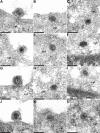Entry of pseudorabies virus: an immunogold-labeling study
- PMID: 15709042
- PMCID: PMC548466
- DOI: 10.1128/JVI.79.5.3200-3205.2005
Entry of pseudorabies virus: an immunogold-labeling study
Abstract
Herpesviruses infect cells by fusion of the viral envelope with cellular membranes, primarily the plasma membrane. During this process structural components of the mature virion are lost from the invading nucleocapsid, which then travels along microtubules to the nuclear pore. We examined the penetration process by immunoelectron microscopy and analyzed which of the major tegument proteins remained associated with the incoming capsid. We show that the UL36, UL37, and US3 proteins were present at intracytoplasmic capsids after penetration, whereas the UL11, UL47, UL48, and UL49 tegument proteins were lost. Thus, the three capsid-associated tegument proteins are prime candidates for viral proteins that interact with cellular motor proteins for transport of nucleocapsids to the nucleus.
Figures



References
Publication types
MeSH terms
Substances
LinkOut - more resources
Full Text Sources

